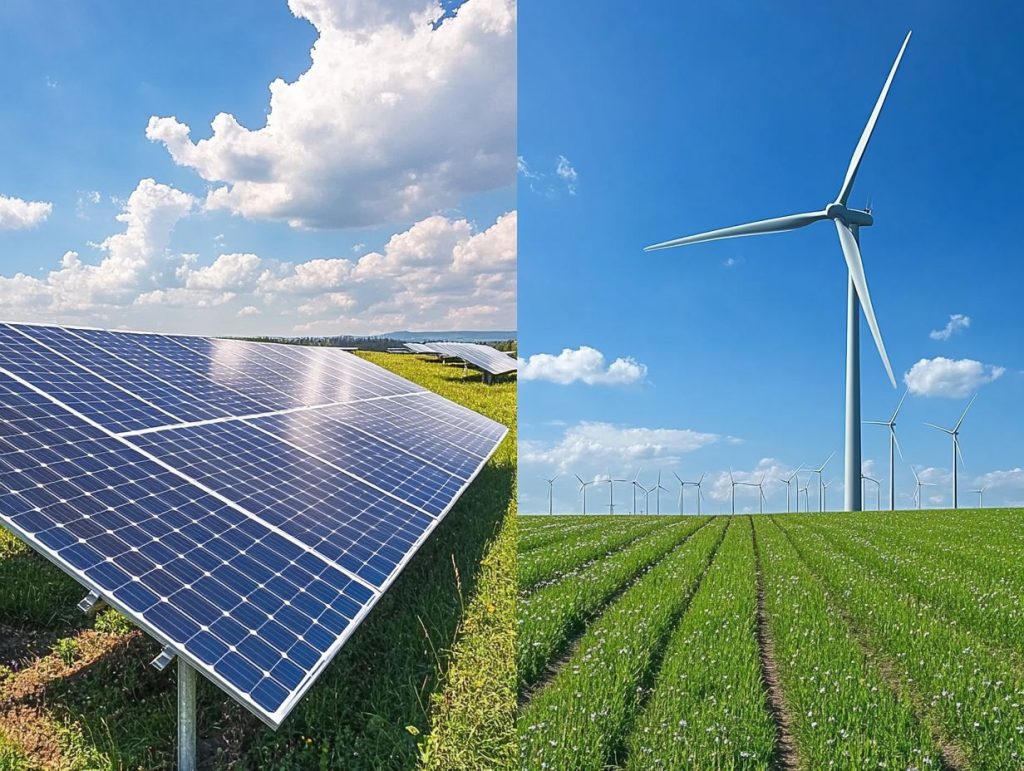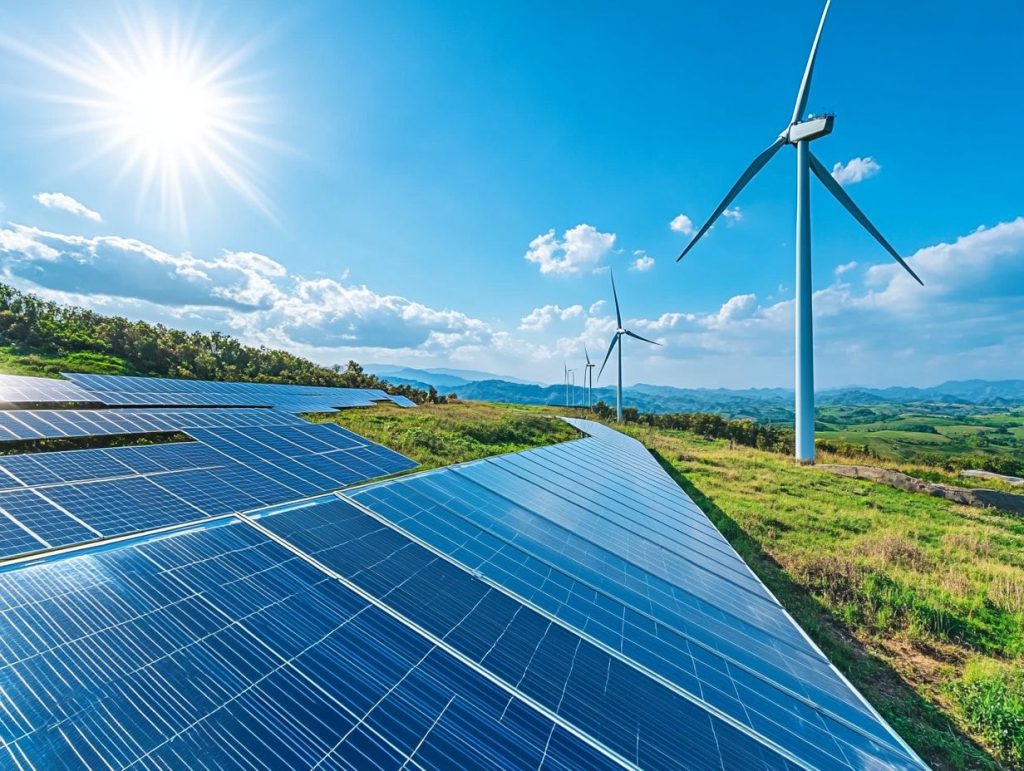Sustainable energy is more than just a buzzword; it’s a crucial part of our effort to combat climate change and create a greener future.
This article unpacks the complexities of solar and wind energy, examining their productivity and the factors influencing their output. We compare these two prominent renewable sources to explore their efficiency and reliability. Additionally, discover how ongoing technological innovations are shaping the landscape of sustainable energy.
Join us as we break down the numbers and uncover what it truly means to harness the power of nature.

Understanding Sustainable Energy
Understanding sustainable energy means exploring renewable sources such as solar and wind energy. These options help you reduce your carbon footprint and improve energy efficiency.
By adopting sustainable energy practices, you can significantly combat climate change and ensure energy security for future generations. This concept highlights how crucial it is to move away from fossil fuels and embrace more sustainable alternatives, along with how government incentives can promote clean technology.
Defining the Concept
Sustainable energy is all about energy production and consumption practices that are good for the environment and make economic sense. The goal is to achieve carbon neutrality and ecological sustainability.
This approach includes a mix of energy sources such as solar, wind, hydroelectric, and geothermal, all creating minimal pollution and relying on resources that naturally replenish themselves. The importance of sustainable energy goes beyond merely needing clean power; it’s about committing to reduce greenhouse gas emissions, tackle climate change, and protect ecosystems.
By embracing sustainable energy solutions, you can significantly reduce reliance on fossil fuels, promoting energy sustainability. This shift helps reduce environmental damage and opens the door for economic growth through job creation in the renewable energy sector. It’s a vital part of building a resilient and responsible energy future.
Productivity of Solar Energy
You’re likely noticing that solar energy’s productivity is rising, all thanks to advancements in photovoltaic systems. Additionally, with government incentives encouraging more solar panel installations, you’re seeing a boost in energy output and efficiency.
It’s an exciting time to be involved in solar energy!
Factors Affecting Solar Energy Output
Several factors affect solar energy output, including environmental conditions, the efficiency of your solar panels, and the performance metrics that track your energy consumption and production.
For instance, changing weather patterns such as cloud cover, humidity levels, and seasonal shifts can significantly impact how much sunlight reaches your solar panels. Your geographical location also plays a crucial role; if you are closer to the equator, you generally receive more direct sunlight throughout the year than those living further north or south.
Moreover, technological advancements—such as the latest efficient photovoltaic cells and solar tracking systems—can significantly enhance your power generation capabilities. All these factors affect energy efficiency and shape the overall environmental footprint of your solar energy system, helping you contribute to the broader goal of sustainability and reducing carbon emissions in the energy sector.
Productivity of Wind Energy
You’ll notice that wind energy productivity has taken off thanks to installing advanced wind turbines. These high-tech beauties enhance wind generation capacity and help diversify energy production, making it a win-win for everyone.
Factors Affecting Wind Energy Output
Wind energy output is influenced by several factors, such as how well resources are optimised, the design of wind turbines, and the local climate conditions that can impact energy generation capacity.
Among these, wind turbine efficiency is significant for effectively harnessing energy. Thanks to technological advances, we now have turbines that can operate in a broader range of wind speeds, which means they can maximise production even when the wind is unpredictable.
Furthermore, using resource optimisation techniques—such as selecting the best sites and forecasting wind patterns—helps ensure that installations are set up to capture the most wind throughout the year. Remember the local climate; areas with consistent, strong winds will naturally see higher energy outputs.
Understanding all these elements is critical for enhancing energy resilience. They help build a more reliable, sustainable energy system that can keep up with our growing demands.

Comparing Solar and Wind Energy
When comparing solar and wind energy, it’s important to consider their efficiency and reliability as renewable energy sources.
These factors are crucial for reducing emissions and enhancing energy generation capacity.
Efficiency and Reliability
Regarding energy generation, you should focus on efficiency and reliability. Solar and wind power come into play here, and you should evaluate them based on how well they operate and how consistently they produce energy.
These factors are crucial for determining whether renewable energy solutions are feasible and successful. When looking at these systems, don’t just consider the average energy output. You must also monitor how production can fluctuate due to changing environmental conditions.
For example, advancements in solar panel technology—like bifacial designs and better inverter systems—can enhance your energy capture capability, ensuring you still get a decent output even when the skies are overcast. On the wind side, modern turbines have improved aerodynamics and intelligent maintenance analytics, which help them generate energy more consistently.
Ultimately, solar and wind energy can enhance reliability by embracing these technological innovations. This means you’ll contribute to a more stable and sustainable energy grid.
The Role of Technology in Sustainable Energy
Technology plays a crucial role in advancing sustainable energy solutions. Think about it—everything from renewable energy technologies like solar panels and wind turbines to the latest improvements in energy storage and grid integration is making a difference.
It’s exciting to see how all these advancements combine to create a greener future.
Ongoing Innovations and Improvements
Technological advancements drive ongoing innovations and improvements in renewable energy, enhancing energy return on investment and sustainability metrics and boosting energy access for everyone.
These breakthroughs cover many developments, such as advanced solar panel designs, improvements in wind turbine efficiency, and the integration of smart grid technologies. These enhancements increase energy efficiency and significantly lower the initial costs of renewable projects, making them more attractive for investment.
As funding in these sectors increases, it opens the door for new installations and infrastructure improvements, helping to tackle those pressing energy accessibility challenges you may be concerned about. The ripple effect of these innovations even extends to localised energy solutions, promoting sustainability and resilience in communities while helping to reduce carbon emissions.
